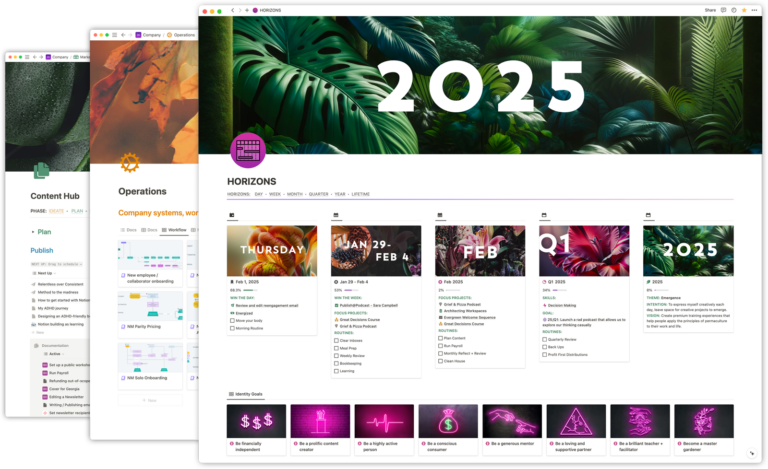As 2022 came to a close, it became obvious that our team’s project planning and management had been lacking structure and focus.
This showed up in the poor ratio of projects we had started (or intended to start) versus what we actually finished, and also in the bumpy unfolding of projects which had been poorly conceptualized.
Where were we going wrong?
Ideas immediately became projects
We have some fantastically inspired idea-generators on our team which means no shortage of great ideas. Our downfall was falling into the trap of hearing an idea, getting excited about it, and immediately turning it into a project without considering our capacity or whether the idea was truly aligned with our current goals. This resulted in our projects database becoming a collection of “someday-maybe” items and way too many “active” projects which were mostly languishing. It created a lot of psychological “debt” having all these projects hanging over our heads, feeling like we should be moving them forward, when realistically we did not have the capacity to do so.
We overestimated our capacity and underestimated timelines
You have probably already guessed by what I’ve shared so far that we were chronically overestimating our capacity. Each of our team members might have a dozen “active” projects on the go. Do-able? Absolutely not. Further, because we were jumping straight into the work without any pre-planning, we were not accurately estimating how long the work would take. A 6 week project was often turning into a 6 month project. No bueno.
Our projects were purely a collection of tasks
Our use of Notion to manage projects amounted to not much more than a linked view of our Actions database in the body of the project, showing a collection of tasks. We were not spending enough (or sometimes any) time conceptualizing what we wanted to do, why it was important, what resources were required, and the integrated sequence of work needed to get to the final outcome.
So, what’s changed?
We have an ideation dashboard

Ideation is inspiring and important to our team. However, ideas had started creating tension. Since almost every new idea became a project, and we couldn’t possibly keep up, ideas started to feel like a threat to our timelines and goals.
We have now established an understanding that ideas are awesome, welcome, and should be expressed, and there is no guarantee an idea will become a project. New ideas are added to our Notes and Ideas database and can be raised for discussion at our weekly syncs. Our Ideate dashboard helps us relate ideas to our current goals, as well as our Staples (the deliverables we are responsible for weekly and monthly within our course and community).
Only the ideas that we (as a team) identify as timely and aligned with our current goals will be elevated to our Projects database. Instead of carrying a lot of project “debt”, we have endless ideas which feel like expansive possibilities, and a more streamlined list of projects.
We updated our project template
Our project database has gone from a glorified list of tasks and resources to an important part of our project conceptualization. Rather than taking an idea and immediately jumping into working on the project, we spend time shaping and planning the project in detail before any actual project work begins.
Our new project template walks us through the following phases:
Shaping
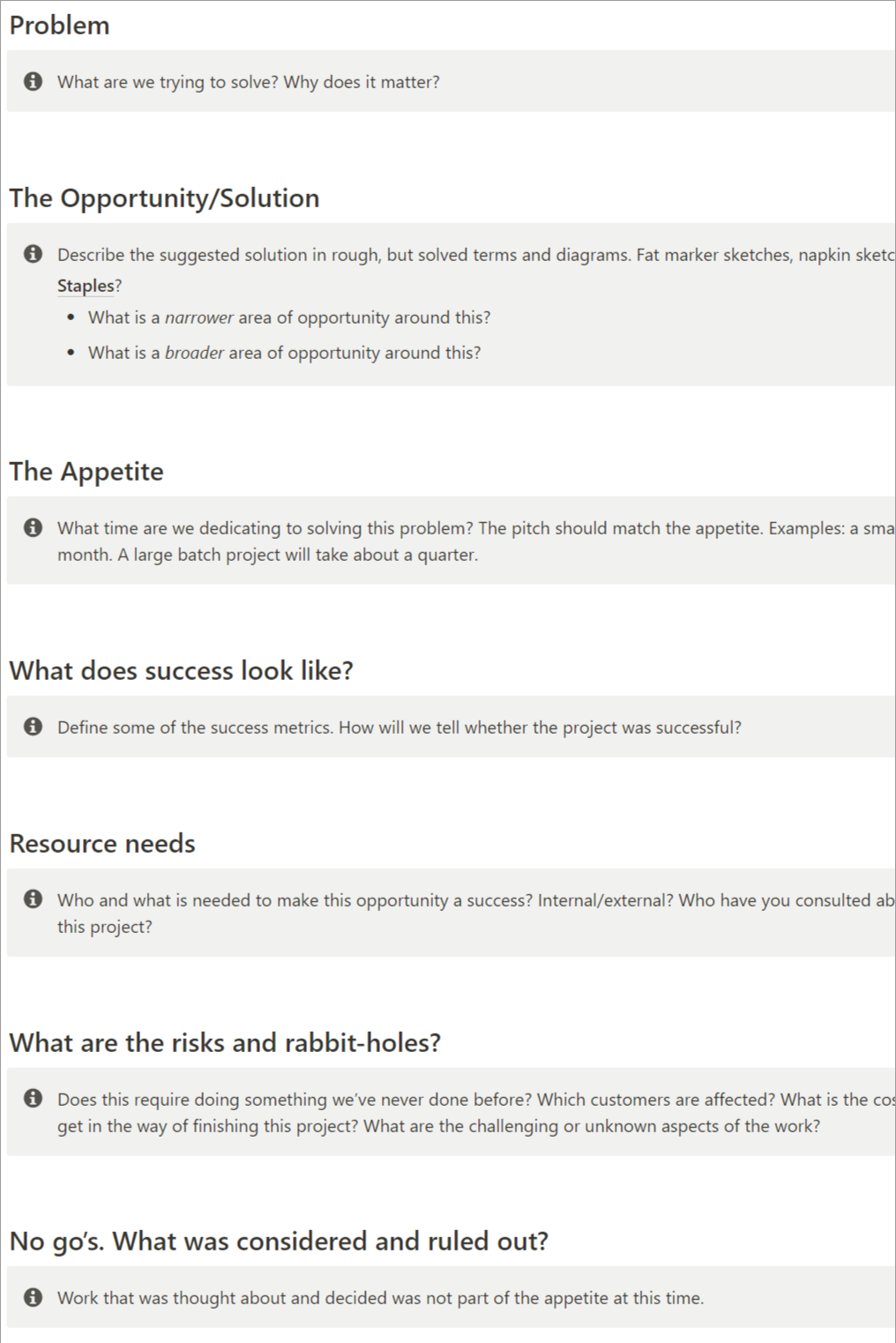
Inspired by Basecamp’s Shape Up we have a series of questions we answer to define the project. These include:
- What are we trying to solve? Why does it matter?
- What is the suggested solution in rough, but solved terms and diagrams?
- What is a narrower area of opportunity around this?
- What is a broader area of opportunity around this?
- What time are we dedicating to solving this problem?
- What does success look like? What are some success metrics?
- Who have you consulted about this work? Who is accountable/responsible/informed/consulted on this project?
- What are the risks and rabbit holes?
- What work was thought about and decided was not part of the appetite at this time?
Once a project is shaped, the team reviews it, shares comments and suggestions, and then the project is marked as Ready to go to planning.
Planning
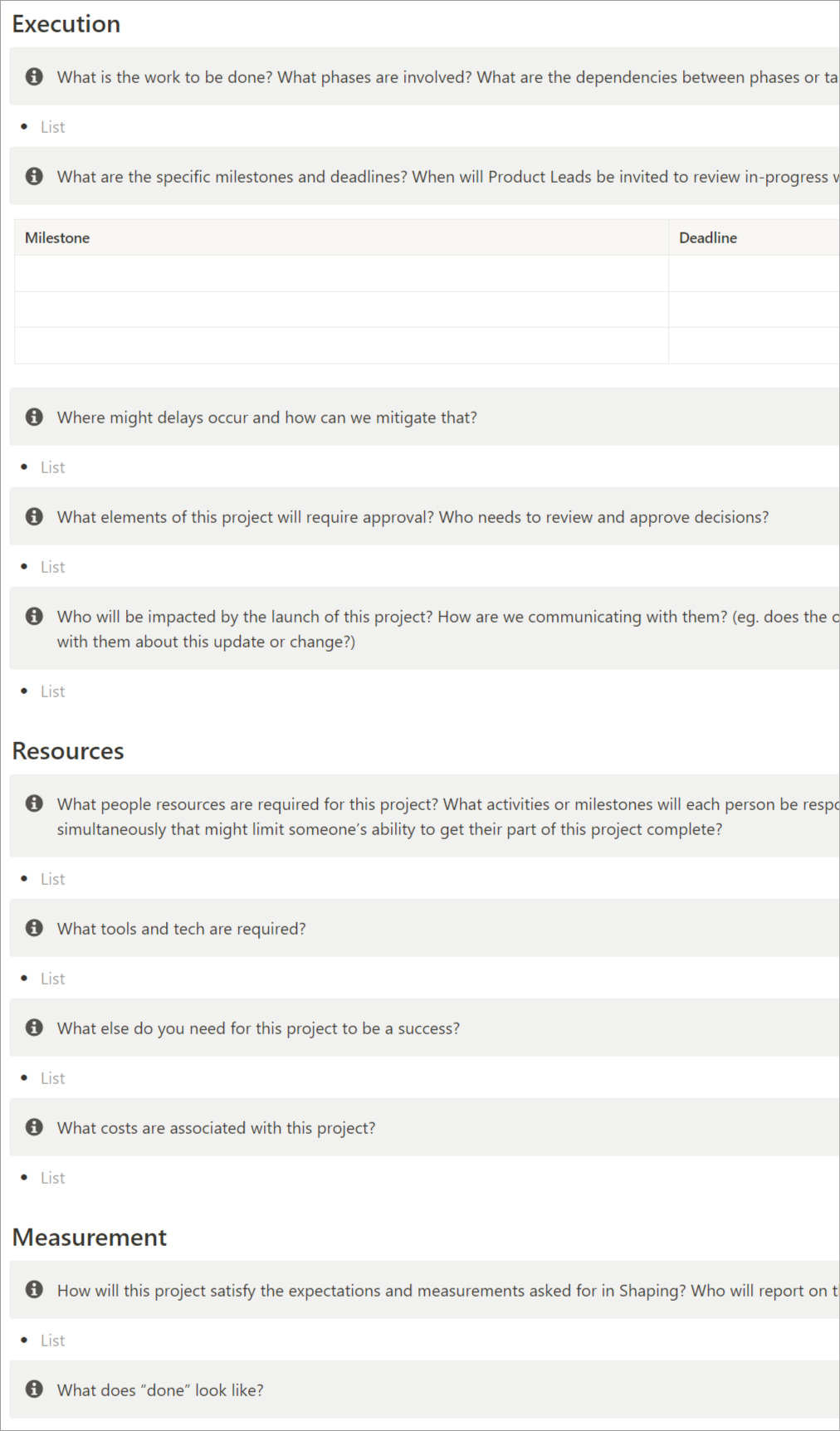
During this phase, we again answer a series of questions that help us thoroughly identify the work that needs to be done. This includes defining:
- What is the work to be done? What phases are involved? What are the dependencies between phases or tasks?
- What are the specific milestones and deadlines? When will Product Leads be invited to review in-progress work? What is the estimated project completion date?
- Where might delays occur and how can we mitigate that?
- What elements of this project will require approval? Who needs to review and approve decisions?
- Who will be impacted by the launch of this project? How are we communicating with them?
- What activities or milestones will each person be responsible for when executing it? Are there other projects happening simultaneously that might limit someone’s ability to get their part of this project complete?
- What tools and tech are required?
- What else do you need for this project to be a success?
- What costs are associated with this project?
- How will this project satisfy the expectations and measurements asked for in Shaping? Who will report on the success metrics outlined and at what intervals?
- What does “done” look like?
Planned projects are reviewed and discussed by the team with the goal being that, as much as possible, nuances and unsaid expectations are brought forward and explicitly defined so we all have a shared understanding of what is to be done. Once a project is planned it will sit until we have the capacity to make it Active.
Active
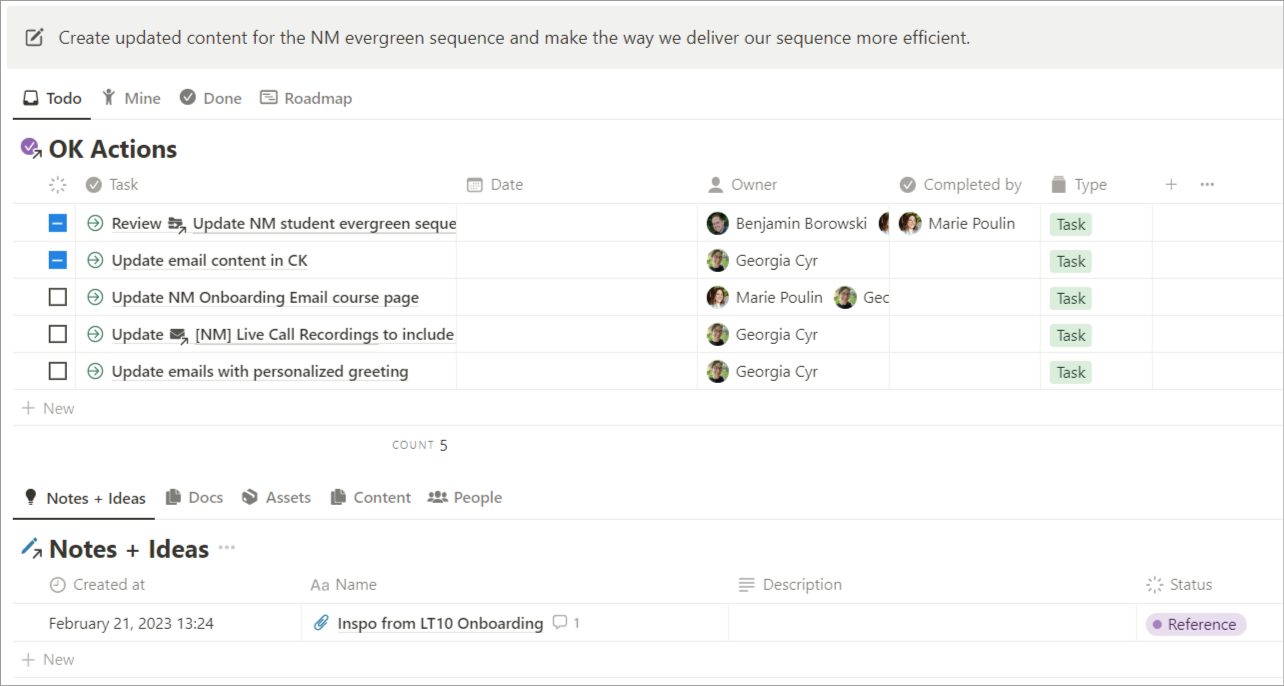
Active projects are ones that we are currently working on. We are making an effort to only activate a project when it will actually be worked on, rather than using the Active status as indicating an intention or “wishful thinking”. When a project is active we are using a linked view of the Actions database to track the tasks that we identified during the planning phase. A linked view of our Notes and Ideas database may also come into play if we have references, inspiration, or research related to the project that we want to refer back to. During active projects our team is collaborating in Notion and any other tools required to fulfill the work.
Measuring
Once a project is complete it moves to measuring. Our projects are quite varied so this is a less standardized phase. The project will be measured against the metrics defined in the shaping and planning phases. Projects ready to be measured are reviewed at our team syncs. Once measurement is complete, the project is moved to a status of Complete.
We’re making our work visible
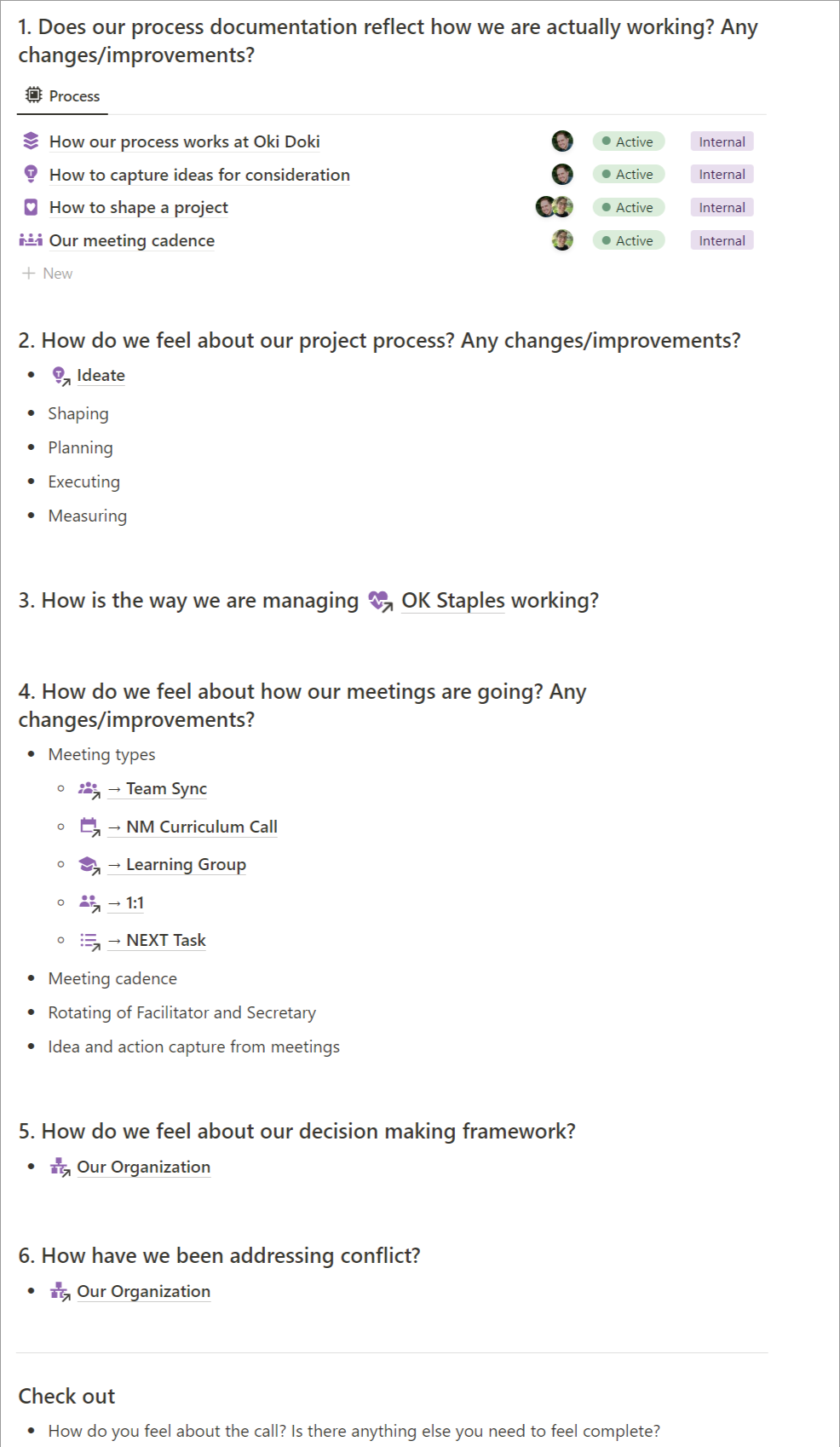
To help us better understand our true capacity, we are using Notion to try to make our work as visible as possible. This includes building in reviews of our Staples (ongoing projects) and project updates at our weekly syncs, and regularly having Process Check-in’s that walk us through a discussion of how we are doing our work and how we would like to make improvements to those processes.
We adopted this new project management process at the start of Q1 2023. Our intention was to take on less and be more realistic about timelines and capacity. As the first quarter of the year winds down, we acknowledge that there is still room for improvement when it comes to our project focus and prioritization!
The intention for the next quarter is to be more ruthless about saying no to anything that is not our number one priority. There will be some difficult no’s as we have a lot of fun and interesting ideas! However, our team shares a desire to be more honest about our capacity and to set more realistic timelines, with the hopes that we can spend more time celebrating what we finished, and less time lamenting that we once again took on way more than we were able to complete.

 Notion tips in your inbox
Notion tips in your inbox